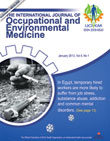فهرست مطالب

International Journal of Occupational and Environmental Medicine
Volume:4 Issue: 1, Jan 2013
- تاریخ انتشار: 1391/10/08
- تعداد عناوین: 7
-
-
Page 2BackgroundNoise, one of the major environmental nuisances, affects the learning ability of children negatively.ObjectiveWith the assumption that in the existing German 4-type school system children are exposed to various noise levels in each type of school, we investigated the association between children''s school type and environmental noise level.MethodsIn this cross-sectional study, we included 550 children—primary and secondary school students—aged 8–12 years, and who lived in 4 Bavarian cities. The environmental noise level was assessed by personal 24-h dosimeter measurements. The associations of interest were assessed by linear regression.ResultsThe average day noise level of 80.0 dB(A) was relatively high, exceeding the threshold level of 60 dB(A). In the model adjusted for sex, socioeconomic status (SES), and place of residence, noise level was significantly higher for primary schools by almost 2.3 dB(A); however, after additional adjustments for age, this association was distorted. The mean night noise level of 43.7 dB(A) was not associated with the school level. We could not find any significant differences in the noise level between different types of secondary schools.ConclusionWe found evidence that in Germany, children, especially of a younger age from primary school, are exposed to high noise levels during day in and outside the school environment. School administration and parents should work to make schools less noisy and more accomplished for learning to achieve a bright future for the children.
-
Page 13BackgroundInformal employment is common in developing countries, including Egypt. This type of employment may have significant consequences on mental health.ObjectivesTo determine the prevalence and risk factors of common mental disorders and substance abuse among temporary hired hospital cleaners.MethodsA cross-sectional study was conducted on 242 adult temporary cleaners and 209 permanent cleaners working in 4 governmental hospitals in Zagazig City, Sharqia Governorate, Egypt. All participants were invited to complete a structured questionnaire through a semi-structured interview which included the self-reporting questionnaire 20 items (SRQ-20) and the work stress scale. Assessment of drug use included urine-based screening tests for common substances abused.ResultsThe prevalence of job stress, common mental disorders and substance abuse, particularly tramadol and cannabis (Bango), was significantly higher in the studied temporary cleaners compared to permanent cleaners. Risk factors associated with increased susceptibility of the temporary cleaners to common mental disorders were family history of substance abuse, high crowding index, history of physical illness, low educational level, and smoking; while being unmarried, male sex, family history of mental disorder, age ≥40 years, smoking, and length of service ≥8 years, were associated with substance abuse among the same group.ConclusionTemporary hired hospital cleaners suffered from impaired mental health more than permanent cleaners. Therefore, expanding the coverage of current laws and occupational safety and health standards to cover workers in the informal sector especially in developing countries is recommended.
-
Page 27BackgroundPrevention of slipping accidents requires provision of adequate friction through the use of suitable combinations of footwear and underfoot surfaces. Shoe sole tread groove is one of the important factors on friction coefficient during walking.ObjectiveTo measure the effect of different shoe sole tread groove depths and different surfaces on the required quotient of friction (Q), heel strike velocity and occurrence time of ground reaction forces (GRF) in stance phase during walking on slippery and dry surfaces.MethodsIn this semi-experimental study, 22 healthy men were studied under different conditions. The studied independent variables were shoe groove depths (included 1, 2.5 and 5 mm) and type of walking surface (dry and slippery). Biomechanical gait analysis was carried out with 396 single steps. Data were collected by motion analysis system and two force platform.ResultsThe occurrence time of GRF was significantly faster on dry surface than slippery surface (p<0.01). Q was significantly lower on slippery surface and with groove depths of 1 and 2.5 mm. The highest value of Q was observed with the deepest groove depth of 5 mm. Heel strike velocity did not differ significantly in the 6 conditions tested.ConclusionTread groove depth is a significant factor affecting the Q at the shoes-surface interface on dry and slippery floors. It seems that deeper groove is more appropriate for maintaining the stability during walking. The walking surface affects the occurrence time of GRF; the force components occur sooner on the dry than slippery surface.
-
Page 36BackgroundLead toxicity is a prevalent health problem in both developed and developing countries. One of the proposed mechanisms for lead-induced organ damage is oxidative stress. Oxidative stress is well-associated with the pregnancy disorder, pre-eclampsia. Exposure to lead may be one of the sources of the oxidative stress that leads to development of pre-eclampsia in pregnant women.ObjectiveTo test if blood lead level of pregnant women suffering from pre-eclampsia is higher than the normal limit.MethodsUsing atomic absorption spectrophotometry, blood lead level was measured in 115 pregnant women suffering from pre-eclampsia and compared to its level in a comparison group of 25 healthy pregnant women in Dakahlia governorate, Egypt.ResultsThe mean±SD blood lead level was 37.68±9.17 μg/dL in women with pre-eclampsia; the value in the comparison group was 14.5±3.18 μg/dL (p<0.001).ConclusionPre-eclampsia is significantly associated with a high blood lead level.Keywords: Pre_eclampsia is significantly associated with a high blood lead level
-
Page 45BackgroundFor its toxicity, benzene exposure is one of the main health concerns for high risk occupations like gasoline station workers. However, there is little knowledge about the effect of benzene metabolites on hematological parameters.ObjectiveTo evaluate the correlation between the urinary level of trans, trans-muconic acid (t, t-MA), a benzene metabolite, and some hematological parameters in gasoline workers.MethodsWe studied 102 gasoline station workers from 11 gasoline stations in Pathumwan district, central area of Bangkok, Thailand. Their blood and urine samples were analyzed for some hematological parameters and urinary t, t-MA analysis by high performance liquid chromatography (HPLC).ResultsWe found an inverse correlation between urinary t, t-MA concentration and hemoglobin level (r = 0.281, p<0.05), hematocrit (r = 0.264, p<0.05). Those with higher urinary t, t-MA had a significantly (p<0.05) lower eosinophil counts than those with lower exposure. No significant correlation was found between urinary t, t-MA level and other white blood cell parameters and platelets count.ConclusionExposure to benzene would cause bone marrow depression presenting as drop in hemoglobin, hematocrit and eosinophil counts.
-
Page 52


